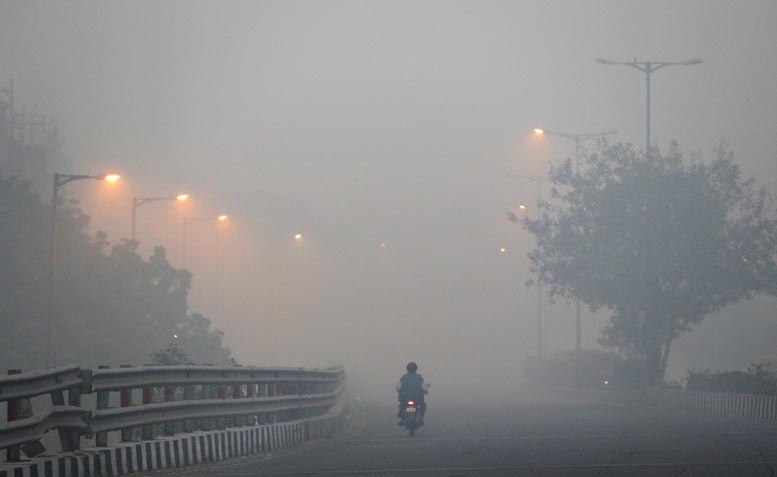
Environment and health issues caused by smog present a huge but surmountable challenge to the policy makers in this region

Talk to anyone born before the 1990s in our part of the world and he/she will relate winters with nice memories of covering oneself with quilts, eating dry fruit (mostly peanuts), sipping (Kashmiri) tea, listening to fairy tales from grandparents, or taking a short dreamy walk into the pollution-free thick fog.
Fast forward to the present days, talk to anyone born after the 1990s in the Indo-Pak subcontinent; the winter memories of this generation would not be complete without the mention of smog, a rather recent problem that has caused concern among the experts and the common people alike.
So, what is smog in scientific terms? Smog is caused by a complex mixture of microscopic particles and liquid droplets (particulate matter or PM) that get into the air and due to their small size and light weight get suspended there. Particulate matters are defined by their diameter. Thus, PM10 is particulate matter with 10 micrometers or less in diameter, and PM2.5 is fine particulate matter 2.5 micrometers or less in diameter. By way of comparison, a human hair is about 100 micrometres, so roughly 40 fine particles could be placed on its width. We can inhale the PMs. The smaller the particles, the deeper they can penetrate into the respiratory system and the more hazardous they are to breathe.
Pakistan stands at 169 in global Environmental Performance Index (EPI) among 180 countries in the categories of environmental health. Every year, air pollution causes 300,000 pre-mature deaths as per estimates of the Lancet Commission.
In 2017, according to the ministry of health, about 1,000 patients were treated on a daily basis for respiratory issues in nine public hospitals of Lahore. Whereas, according to World Health Organisation, in 2015, sixty thousand deaths were attributed to fine particulate matter in Pakistan.
Particulate matter (PM 2.5) is released from industries, vehicles, brick kilns and crop burning. Its emissions are high when farmers in India and Pakistan practise stubble burning after harvesting rice. According to a study, farmers burn 30-90 percent of crop residue in India (Punjab) (Lohan et.al 2017) whereas Pakistan (Punjab) constitutes for 72 percent to the smog formation in the region (Irfan et.al 2015).
According to an image released by NASA last year (November 2017) a thick blanket of air was observed on areas of India and Pakistan due to crop burning in the region. During this time levels of particulate matter were much higher than the permissible limit set by World Health Organisation (permissible limit is 10 μg/m3 annual mean).
Coming back to scientific terminology, estimated levels in Lahore were as high as1,077 micrograms per cubic meter whereas in New Delhi (India) levels were 1010 micrograms per cubic meter. On November 1, 2018 levels of particulate matter are 445.4 µg/m³ in Lahore whereas 147.2 µg/m³ in New Delhi. This amount is dangerously high.
There is quantitative relationship between exposure to particulate matter and deaths. According to doctors based in New Delhi, breathing in this polluted air is equivalent to smoking a pack of cigarette. Particulate matter can penetrate down to lungs and cause cancer. Women and children are more vulnerable to respiratory issues and choking of throat due to smog. It also causes nonfatal heart attacks, irregular heartbeats, reduced lung function, aggravated asthma, and increased respiratory problem symptoms.
Smog not only affects health but also day-to-day business. Last year, 20 deaths were reported in two days in Lahore due to reduced visibility. Around 30 flight operations were suspended, schools remained close. In India, 6,000 schools remained closed affecting education of millions. Coal power plants in India remained closed temporarily and Pakistan closed 180 factories to minimise particulate concentration. Health emergency was declared in hospitals. Provincial government of Punjab (Pakistan) formulated smog policy in emergency that, too, without availability of data.
Currently, the government of Pakistan is working to regulate brick kilns whereas government of India put a ban on fire crackers (cause of smog) on Diwali. Both are short-term and ineffective ways to tackle this issue.
Farmers need to be given awareness on the harmful impacts of crop residue burning. Modern harvesters are part of the problem as to avoid any damage to their blades, they cut the rice stem few inches above the land, leaving behind stubble residues.
Technological improvement in rice harvester is required to overcome this problem. An alternative is to bury those residues in the soil while cultivating the land for next crop. This would also help in improving soil fertility. Environmentally friendly techniques are required for brick kilns. Pakistan and Switzerland have been partnering in this sector, about 10 years ago. That partnership needs to be revised. The objective is to reduce emission of particulate matter from the air.
Entrepreneurs, scientists and industrialists should come forward with an alternate use of crop residue as fodder for animals, bedding material for animals in winters, mushroom cultivation, paper production generation of energy from thermal power plants and bio gas generation.
Long-term solution is needed on the ground. Only blaming others for smog would not provide a solution. The first step can be doing research to quantify emissions from each sector, i.e., industry and agriculture on a regular basis.
We should start negotiating with India and sign an agreement for the control of smog as it affects health and economy in both the regions. The 2005 WHO air quality guidelines offer global guidance on thresholds and limits for key air pollutants that pose health risks. The guidelines indicate that by reducing particulate matter (PM10) pollution from 70 to 20 micrograms per cubic metre (μg/m3), we can cut air pollution-related deaths by around 15 per cent. Is our government ready for this?
The writer is an environmental expert at Sustainable
Development Policy Institute,
Islamabad.
She tweets at @S_Maryam8